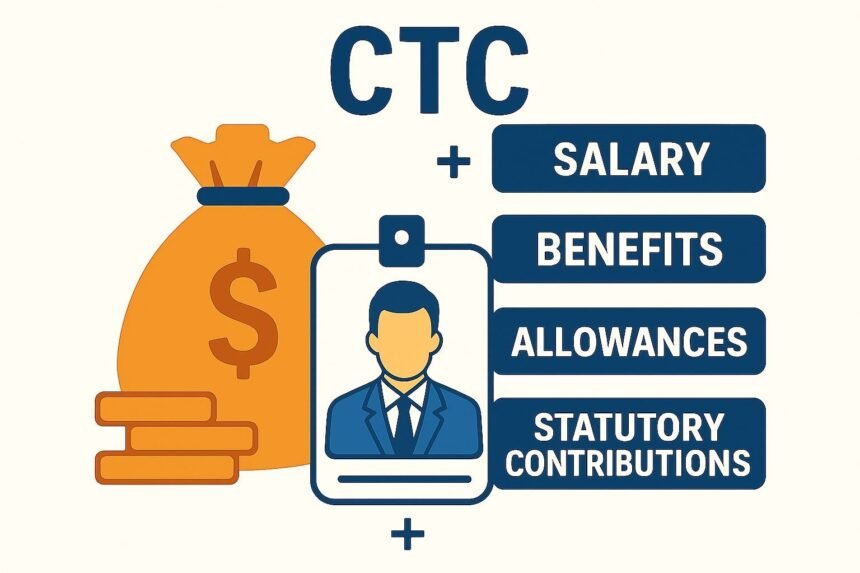Table of Content
- What is CTC’s Meaning and Its Full Form
- Components of CTC
- Key Features of CTC
- Difference Between CTC and Gross Salary
- How to Calculate CTC
- What Does Expected CTC Mean?
- Advantages of CTC Structure
- How CTC Works in Practice
- Conclusion
Job offers often include terms like CTC, gross salary, and take-home pay without clear explanations. This may cause uncertainty regarding actual income. Candidates can make wrong assumptions about the worth of a compensation package without being knowledgeable about these components. This guide answers such questions as what CTC is, how it is calculated, and how to estimate its effect on your monthly income.
What is CTC’s Meaning and Its Full Form
CTC Full Form: Cost to Company
Current CTC Meaning: The annual amount that a company spends on the employment of an individual, which is inclusive of salary, benefits, allowances and statutory contributions.
What is CTC in Salary: CTC is not only salary. It is the total cost structure that comprises the basic pay along with all other benefits such as house rent allowance, medical insurance, provident fund contribution and other benefits.
The CTC is the total financial package which indicates the cost of hiring and retaining an employee to the organisation. It includes direct compensation to the employee and indirect expenses such as insurance premiums, retirement fund contributions, and other benefits.
Components of CTC
Being aware of the elements of CTC will enable you to evaluate your salary package. The key components of CTC are a basic salary, allowances, statutory benefits, and other benefits provided by the employer.
Basic Salary
The fixed monthly payment that forms the foundation of the CTC. This typically ranges from 40% to 60% of the total CTC.
Allowances
- House Rent Allowance (HRA): Usually 40% to 50% of basic salary for metro cities, 30% for non-metro cities
- Dearness Allowance (DA): Compensation for inflation, common in government jobs
- Transport Allowance: Money for commuting expenses
- Medical Allowance: Coverage for healthcare expenses
- Food Allowance: Meal or food voucher benefits
Statutory Benefits
- Provident Fund (PF): 12% of basic salary contributed by the employer
- Employee State Insurance (ESI): 3.25% of gross salary for employees earning up to ₹21,000 per month
- Gratuity: 4.81% of basic salary for employees who complete 5 years of service
Additional Benefits
- Medical Insurance: Health insurance premiums paid by the company
- Life Insurance: Life insurance coverage provided by the employer
- Performance Bonus: Annual bonus based on individual or company performance
- Leave Travel Allowance (LTA): Reimbursement for vacation travel expenses
Key Features of CTC
- Comprehensive Cost Structure: CTC provides a complete picture of employment costs, making it easier for companies to budget for human resources.
- Standardized Comparison: With CTC, comparison of various job offers can be fairly made because all the benefits, as well as costs, are factored in.
- Tax Planning Benefits: Several elements of CTC provide tax benefits to employees, including HRA exemptions and medical insurance deductions.
- Flexibility in Structure: Companies may change various elements of CTC to ensure that the tax benefits of employees are maximised and the expenses are controlled.
Difference Between CTC and Gross Salary
Most employees get confused between CTC and gross salary, and it is important to know the difference between CTC and gross salary when it comes to proper salary planning:
How to Calculate CTC
It is important to know how to calculate CTC so that you can know how much you are receiving in total compensation. To calculate CTC, sum up all the components of salary, as well as employer contributions:
Basic CTC Calculation Formula:
CTC = Basic Salary + Allowances + Statutory Benefits + Additional Benefits + Employer Contributions
Example Breakdown:
1. Basic Salary
- ₹30,000 per month × 12 = ₹3,60,000 per year
2. Allowances
- House Rent Allowance (HRA): ₹15,000 × 12 = ₹1,80,000
- Transport Allowance: ₹2,000 × 12 = ₹24,000
- Medical Allowance: ₹1,500 × 12 = ₹18,000
Total Allowances = ₹2,22,000
3. Statutory Benefits (Employer Contributions)
- Provident Fund (PF): ₹3,600 × 12 = ₹43,200
- Employee State Insurance (ESI): ₹975 × 12 = ₹11,700
- Gratuity: ₹1,443 × 12 = ₹17,316
Total Statutory Benefits = ₹72,216
4. Additional Benefits
- Medical Insurance: ₹15,000
- Performance Bonus: ₹50,000
Total Additional Benefits = ₹65,000
Total CTC = ₹3,60,000 (Basic) + ₹2,22,000 (Allowances) + ₹72,216 (Statutory) + ₹65,000 (Benefits)
= ₹7,19,216 per year
When you calculate CTC using this method, you get a complete picture of the employment cost from the company’s perspective.
What Does Expected CTC Mean?
Expected CTC means the total compensation package a job candidate wants from a potential employer. When recruiters ask “what is your expected CTC,” they want to understand the complete annual cost you expect for your employment.
Expected CTC means more than just your desired salary. It includes:
- The salary amount the candidate expects to receive
- All the benefits and allowances they want
- Insurance and retirement benefits
- Any additional perks or bonuses
Learning what the expected CTC means helps you provide realistic figures during salary negotiations and ensures both parties have clear expectations about the total compensation package.
Advantages of CTC Structure
A well-defined CTC helps in the following ways:
For Employers
- Better Cost Management: Clear visibility of overall employee expenses.
- Budget Planning: Annual human resource budgets are simpler to plan.
- Competitive Positioning: Ability to create competitive packages within budgets.
- Compliance Management: Makes sure that all the statutory requirements are fulfilled.
For Employees
- Tax Benefits: Some components give tax exemptions and deductions.
- Comprehensive Benefits: Access to insurance, retirement benefits, and allowances.
- Clear Expectations: Understanding of total compensation package.
- Financial Security: Multiple benefit components provide financial protection.
How CTC Works in Practice
Salary Negotiation Process
When negotiating salary, both the employer and the employee discuss the CTC amount. The employer then breaks down this amount into different components based on company policy and tax optimisation.
Monthly Salary Calculation
The monthly take-home salary is calculated by:
- Taking the annual CTC
- Removing employer-only contributions (PF, ESI, gratuity)
- Dividing the remaining amount by 12 months
- Subtracting employee tax deductions and contributions
Annual Review Process
Companies typically review and adjust CTC annually based on:
- Employee performance
- Market salary trends
- Company financial performance
- Inflation adjustments
- Role changes or promotions
Conclusion
Knowing what CTC is and how to calculate it helps you make smarter career choices by giving you a clearer picture of your actual earnings. CTC or Cost to Company includes your salary along with benefits, allowances, and employer contributions. Learning the gap between CTC and take-home pay helps you plan your finances better. During interviews, being aware of each component allows you to set realistic expectations and negotiate confidently. This guide helps you assess job offers with clarity and precision.
FAQs
1. How is total CTC calculated by employers?
To calculate CTC, companies add together the basic salary, allowances, employer contributions to benefits like PF and gratuity, and any additional perks such as bonuses or insurance. It reflects the total cost the company will incur for one employee in a year. This includes both direct payments made to the employee and indirect benefits.
2. What does ‘expected CTC’ mean during recruitment?
Expected CTC means the total amount a candidate hopes to receive from a potential employer in a year. It includes the desired salary, bonuses, insurance, and other employer-paid benefits. Recruiters ask for this figure to assess if a candidate’s expectations align with the company’s budget. Being clear on the expected CTC helps avoid confusion during offer negotiations.
3. What is the full form of CTC, and how is it used in salaries?
For those wondering what is CTC, the CTC full form is Cost to Company. It refers to the total annual amount a company spends on an employee, including salary, allowances, and employer-paid contributions. This figure helps represent the complete value of the job offer. However, it’s important to note that not all parts of the CTC are received as monthly take-home pay.
4. What is the meaning of ‘current CTC’?
Current CTC meaning refers to the full compensation an employee is earning in their present role. It includes the basic pay, various allowances, employer contributions to retirement funds, and benefits like insurance. This total helps employers benchmark a candidate’s salary before making an offer. It’s commonly used during job interviews and salary negotiations.
5. What are the components of a standard CTC?
The typical components of CTC include basic salary, house rent allowance, medical and travel allowances, and performance bonuses. It also covers employer contributions to the provident fund, gratuity, and insurance plans. Each company may structure CTC differently based on its policies and budget. Understanding each component helps in assessing the actual monthly earnings.







